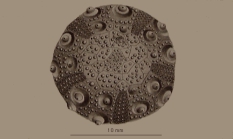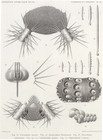WoRMS name details
Miracidaris Lockhart, 2006
558696 (urn:lsid:marinespecies.org:taxname:558696)
unaccepted > nomen nudum (unpublished name)
Genus
Aporocidaris incerta (Koehler, 1902) (type by original designation)
- Species Miracidaris incerta (Koehler, 1902) accepted as Aporocidaris incerta (Koehler, 1902) (genus name invalid)
marine, brackish, fresh, terrestrial
recent only
Lockhart, S. J. 2006. Molecular evolution, phylogenetics, and parasitism in Antarctic cidaroid echinoids. unpublished Ph.D. thesis, University of California, Santa Cruz, 151 pp., available online at http://proquest.umi.com/pqdlink?did=1251818701&Fmt=7&clientI d=79356&RQT=309&VName=PQD [details]
Status Established in an unpublished Ph.D. thesis and therefore not available according to ICZN regulations.
Taxonomy Primary spines with "hairy" aspect of the cortex in Ctenocidarids were interpreted as infected by Echinophyces mirabilis, a...
Status Established in an unpublished Ph.D. thesis and therefore not available according to ICZN regulations. [details]
Taxonomy Primary spines with "hairy" aspect of the cortex in Ctenocidarids were interpreted as infected by Echinophyces mirabilis, a...
Taxonomy Primary spines with "hairy" aspect of the cortex in Ctenocidarids were interpreted as infected by Echinophyces mirabilis, a microorganism living in the stereom
of the spines, which was tentatively identified as a fungus. [...] Recently, Lockhart (2006, unpubl. molecular data from 18S ribosomal gene) demonstrated that specimens formerly attributed to the effect of the parasite—were actually not phylogenetically related to “normal” specimens of their respective species, but to each other. Consequently, she erected the genus Miracidaris to gather those “transformed” specimens, casting doubt upon the supposed effects of E. mirabilis. [...] Lockhart has, however, also clearly said that E. mirabilis exists and is a symbiont (putatively a parasite) on the primary spines of representatives of several species. [details]
of the spines, which was tentatively identified as a fungus. [...] Recently, Lockhart (2006, unpubl. molecular data from 18S ribosomal gene) demonstrated that specimens formerly attributed to the effect of the parasite—were actually not phylogenetically related to “normal” specimens of their respective species, but to each other. Consequently, she erected the genus Miracidaris to gather those “transformed” specimens, casting doubt upon the supposed effects of E. mirabilis. [...] Lockhart has, however, also clearly said that E. mirabilis exists and is a symbiont (putatively a parasite) on the primary spines of representatives of several species. [details]
Kroh, A.; Mooi, R. (2024). World Echinoidea Database. Miracidaris Lockhart, 2006. Accessed through: World Register of Marine Species at: https://www.marinespecies.org/aphia.php?p=taxdetails&id=558696 on 2024-04-18
![]() The webpage text is licensed under a Creative Commons Attribution 4.0 License
The webpage text is licensed under a Creative Commons Attribution 4.0 License
original description
Lockhart, S. J. 2006. Molecular evolution, phylogenetics, and parasitism in Antarctic cidaroid echinoids. unpublished Ph.D. thesis, University of California, Santa Cruz, 151 pp., available online at http://proquest.umi.com/pqdlink?did=1251818701&Fmt=7&clientI d=79356&RQT=309&VName=PQD [details]
basis of record David, B.; Stock, S. R.; De Carlo, F.; Hétérier, V.; De Ridder, C. (2009). Microstructures of Antarctic cidaroid spines: diversity of shapes and ectosymbiont attachments. <i>Mar Biol</i>. 156(8): 1559-1572., available online at https://doi.org/10.1007/s00227-009-1192-3
page(s): 1570 [details]
basis of record David, B.; Stock, S. R.; De Carlo, F.; Hétérier, V.; De Ridder, C. (2009). Microstructures of Antarctic cidaroid spines: diversity of shapes and ectosymbiont attachments. <i>Mar Biol</i>. 156(8): 1559-1572., available online at https://doi.org/10.1007/s00227-009-1192-3
page(s): 1570 [details]
 Present
Present  Inaccurate
Inaccurate  Introduced: alien
Introduced: alien  Containing type locality
Containing type locality
From editor or global species database
Status Established in an unpublished Ph.D. thesis and therefore not available according to ICZN regulations. [details]Taxonomy Primary spines with "hairy" aspect of the cortex in Ctenocidarids were interpreted as infected by Echinophyces mirabilis, a microorganism living in the stereom
of the spines, which was tentatively identified as a fungus. [...] Recently, Lockhart (2006, unpubl. molecular data from 18S ribosomal gene) demonstrated that specimens formerly attributed to the effect of the parasite—were actually not phylogenetically related to “normal” specimens of their respective species, but to each other. Consequently, she erected the genus Miracidaris to gather those “transformed” specimens, casting doubt upon the supposed effects of E. mirabilis. [...] Lockhart has, however, also clearly said that E. mirabilis exists and is a symbiont (putatively a parasite) on the primary spines of representatives of several species. [details]

